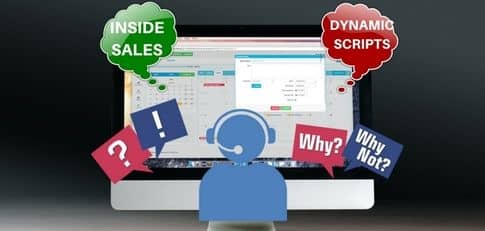
One of the things that sales managers and CEOs have to decide while setting up an inside sales operation is the script. Do your sales reps need a script, or is your product or solution too complex to be marketed and sold using the same script over and over again to different customers?
You don’t necessarily have to pick one of these and forego the advantages the other option provides. One solution that combines the best of fixed sales scripts and a free-wheeling conversation is dynamic inside sales call scripting.
How does it work? The answer lies in logical branch scripting. Define the stages of your sales, and anticipate possible answers and objections for each stage. Create the answers for each of these multiple branches at every stage, and you have your dynamic sales call script. Your sales reps merely have to start with an introduction, and then follow the flow based on responses.
Your sales reps or BDRs don’t have to memorize all of it, and know which one is the right answer to which response. There are interactive sales tools such as Vanillasoft that will take you through the call step by step, providing the right answers at each step based on the response provided by the lead.
1. Define the logical flow of your sales call.
A sales call begins with an introduction and/or a qualifying question, which is met by an answer that requires an engagement that is the core part of your sales pitch. The subsequent answer will either be a ‘yes’ which closes the deal, or an objection that needs to be handled. If handled appropriately, it then takes you to the close.
2. Methods to qualify leads for engagement.
The first variant here is the lead’s initial answer to your qualifying questions, which decides your engagement. We have a very useful post on getting your prospects to reveal their budgets up-front. These questions (BANT; second decision, and; what are you spending now?) in the aforementioned link can be used as your qualifying questions.
3. Prepare a full set of responses for handling common objections.
Once you’ve made enough sales calls and analyzed the call transcripts, you’ll have a full list of common objections, and the responses from your top performers to these objections that resulted in sales. Prepare these answers and feed them into your sales playbook, and your dynamic sales scripting tool, if you have one.
An easier way would be to ask what they are spending now, or what is their spending limit, but it may not be something that a B2B buyer wants to share right away. So you pose the qualifying question about the budget. If you get the right answer, fine. If their budget is too low, then you move on to the next prospect. If they say they don’t know, then you pose the followup.
This is the kind of response and logical flow that you develop for each objection and response likely to come up in a sales call.
4. Sales scripting tools to manage dynamic flows.
Vanillasoft Call center scripting software;
SalesScripter – Sales training software that helps sales managers and reps build inside sales scripts;
SurveyMonkey – They answer 16 million questions every day, and it’s a robust platform to come up with an interactive question and answer session framework.